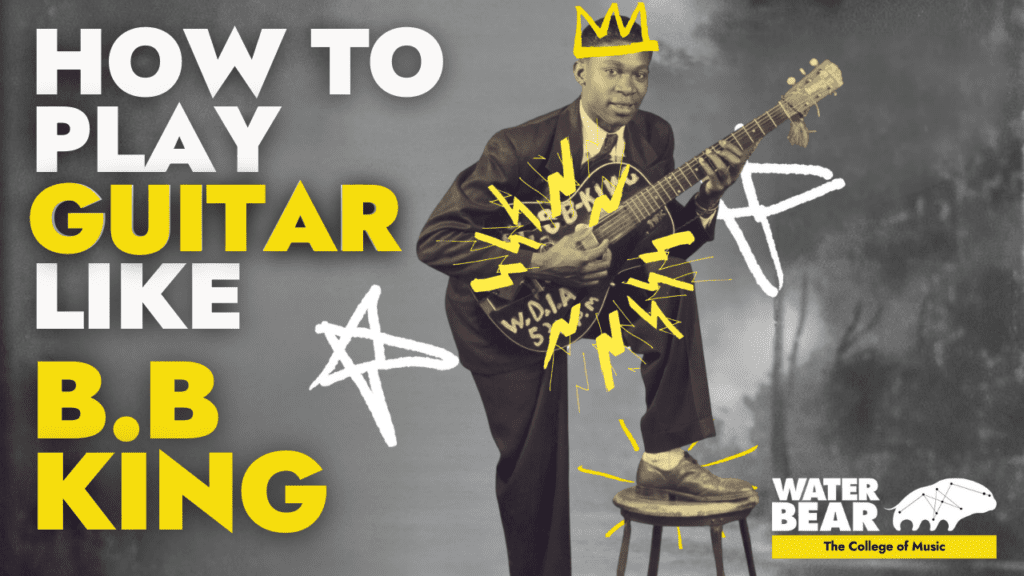JOIN US SEPTEMBER 2024 - APPLY TODAY OR BOOK YOUR PLACE ON ONE OF OUR OPEN DAYS IN BRIGHTON OR SHEFFIELD. UCAS CLEARING IS NOW OPEN.
JOIN US SEPTEMBER 2024 - APPLY TODAY OR BOOK YOUR PLACE ON ONE OF OUR OPEN DAYS IN BRIGHTON OR SHEFFIELD. UCAS CLEARING IS NOW OPEN.

It’s a smoky, wet paved night in the windy city of Chicago. November 21st 1964 could’ve been any other night in the impoverished area, but down at the Regal Theatre something special was taking place. BB King was playing to an energetic, vibrant crowd made up of enthusiastic youngsters who were revelling in the new blues boom. As the curtains lift, the audience screams as he walks onto the stage and the sound crew starts recording what will be remembered as one of the best live albums ever made and one which will influence every blues player to follow it.
The King of Blues failed to hit a bad note, his playing was the definition of touch and class with a buttery tone which is instantly recognisable. BB’s ability to phrase and use vibrato was like no other, and his influence can be found in all genres, in players of all instruments. So let’s look at what we can learn from such a towering guitar titan and how his playing can shape our own.
On September 16th 1925, near the tiny village of Itta Bena, the greatest bluesman to pick up a guitar, Riley B King, was born. Nestled deep in the swamps and mangroves, scored by the sounds of crickets and birds, Itta Bena was isolated and devoid of work or opportunity. For more stable income, when he was around 5, Riley’s mother moved the pair to be nearer her family on a farm still in the Mississippi, where he picked cotton, corn and milked cows. It was here that King would have his first encounter with the blues.
The owner of the farm was, according to King, fair by farm owner standards - allowing lively church services and gatherings with music to take place. One of King’s family friends was the preacher, Reverend Fair, who taught Riley his first chords and got him singing at services. This along with his aunt’s gramophone, which played Blind Lemon Jefferson and Lonnie Johnson, was Riley’s introduction to music, especially early blues, and would lay the foundations for his life’s work.
Riley had a tumultuous early life, losing his mother and grandmother at a young age, he lived for a while alone in a cabin amongst the trees whilst still working the cotton fields. Later he became a tractor driver, partook in military enrolment (but never served) and even got married. At around twenty-three he moved to Memphis and got his first gigs down the famous Beale St. This led to working on the radio and attaining his legendary nickname, ‘The Beale St Blues boy’ which later became ‘Blues boy’ and finally ‘BB’.
One of the songs which took this author and probably countless other players from learning the odd Peter Green or John Lee Hooker line deeper into the blues and opening the door to more sophisticated turn arounds was ‘The Thrill is Gone’. The track could possibly be the definition of the blues. Originally written in 1951 by Roy Hawkins and Rick Darnell, BB King’s cover was released in 1969 where it charted number 3 and number 15 on the Billboard RnB and pop charts respectively. The lyrics tell a story of a person wronged by a partner and taking the consequence of being lonely to escape the relationship.
The song is built around a 12 bar blues in B minor, using the root chord of Bm7, the 4th chord Em7 and the 5th chord, which although normally is a F#m, in this context is an F#7. This is a common substitution, as the dominant 5th contains the major 7th of the root (in this context a F#7 contains F#, A#, C# and E, the A# being the major 7th of B), creating more tension to pull back to the 1 chord. Another deviation to the 12 bar format which makes it sound more melancholic comes in the turn around, where a GMajor7 is played for a bar before descending through a bar of F#7sus4 to F#7, to then pull back to the Bm7. The GM7 doesn’t muddle things for soloists, sharing the notes B, D and F# with the B minor pentatonic scale, it allows for the same lines used over Bm7 and Em7 to work perfectly over it. Another way to simplify viewing this is to play a standard Bm chord and then just play a G in the bass, it’s a GM7! By adding the GM7 it adds a natural minor (Aeolian) flavour to the progression, just with a substituted dominant fifth.
We can steal interesting ideas from just the chord progression, including dominant substitutions and the way chords can give a song a modal theme. The flat 6th down to 5th to root chord movement is very common and a great way of adding emotion and the feeling of a descending ‘happy, tension, sad’ resolution. Playing around with modal flavours can also open up a lot of song writing doors, from obvious examples like Metallica’s ‘Wherever I May Toam’ which is very Phrygian to the more subtle Brain Adams ‘Run to You’ which uses Dorian.
In 1988 when BB played and toured with U2, he is infamously quoted as saying, during the recording of a feature track, that he didn’t play chords and someone else would need to play them. Although as proven in lessons BB gave later in life and just the content of his phrases played in ‘The Thrill Is Gone’, it was obviously a matter of choice as he definitely knows his chords. Over the track, BB gives a masterclass in blues phrasing and how the guitar can sing. Over a minor blues like ‘Thrill is Gone’, BB King is at home in his normal fretboard position, the bottom half of the second position of minor pentatonic.
This position contains the D minor shape from the CAGED pattern with the root on the B string, having the triad itself laid out on the thinner strings really works for BB who is famous for his big bends and unique vibrato. The song itself starts with a rake into the root note on the B and then a descending line from the third on the E string to the root on the D string, a perfect demonstration of the box shape in use. BB King’s soloing style is all about articulation; he could make 4 notes sing and tell more stories than most could make a whole scale. His vibrato is fast and energetic, achieved from pivoting between the neck and just after the knuckle of his first finger, in almost a circular motion. His bending technique is similar, where the strength in his first finger shows, often utilising the ‘blues curl’ lifting the minor 3rd up to the major 3rd, a move commonly found over a minor blues.
BB King’s soloing goes up a notch during ‘The Thrill is Gone’ when the turnaround approaches where his clever note choices let the chords do the work, perfectly demonstrated during his Montreux performance. When the GM7 and F# come around you can often hear him articulately pick out notes from the related major 7 and dominant 7 arpeggios and he sometimes uses chromatics to fill in the gaps. This technique is great when tackling a backing track which perhaps uses non-diatonic chords, just remember or listen for when the chords arrive and treat them as their own entity until you can follow it back into key, a very similar idea underpins the basics of bebop soloing and so gives a slightly jazz sound to your phrases.
‘Sweet Little Angel’ is a great track off of BB King’s second album ‘The Blues’ which was released in 1958 and, like the rest of the album, is more of a straight-ahead typical blues. The album, being obviously one of his earlier recordings and on a lower budget, is a lot rawer production wise, especially when compared to his ’69 album ‘Completely Well’ which featured the track discussed above. ‘Sweet Little Angel’ is built around a very standard 12 bar blues in C#. Using only dominant chords, it’s a quintessential 1-4-5 blues making it a perfect track to practice and learn dominant blues soloing.
There is an exceptional live version on YouTube with an extended intro where BB really shows what he can do and how the ‘BB Box’ can be fully utilised. The BB box can be used over any major or dominant blues and is considered to be the area on the B and E strings around the root note. Just imagine a D shape major triad with the major pentatonic laid out a few frets ahead. I personally think of the area as the bottom half of an Ionian shape, so in this case to get it in C# mixolydian, I would just picture F# major from the G to E strings, resolving lines on chord tones. In the intro of the live version, you can also hear BB outlining chord changes and using some chromaticism, definitely a product of Django Reinhardt’s influence who apparently, he discovered when he moved to Memphis. We can borrow the BB box to help us create simple yet emotive phrases for tackling soloing over a dominant chord progression, mixed in with skilful, nuanced bends and occasional ‘join the dot’ chromatics and we have some solid tools to put to use.
An important takeaway from the King’s playing style is to think more like a saxophonist or a vocalist, not being afraid of space and getting every last emotive drop from a sustained note or buttery bend. BB King’s playing epitomises simple done well, his playing doesn’t contain sweep picked passages or long extensive bebop lines and it doesn’t need to. Even in the first few bars of ‘Thrill is Gone’ BB uses a vast dynamic range, he played his phrases like spoken ones, knowing which notes to emphasize and dig in on and which to leave softly spoken.
BB also reminds us to practice vibrato, it’s something we use all the time and adds character and nuance to notes. One of the best ways to practice it is by simply listening to players who you wish to emulate and then listening to recordings of yourself - what can you change to get that sound that is in your head? BB once famously said that he knows what he sounds like and he knows what he wants to sound like, but the two have never aligned and if they did he’d have nothing left to chase.
BB King has pretty much a spotless discography in terms of recommended further listening. Live at the Regal is an amazing live album and a masterclass in how to play a crowd, a skill which BB mastered with his confidence, talent and charisma. As noted by Joe Bonamassa, BB could get a standing ovation by just walking on the stage. The King appeared countless times on stages with other blues legends like Buddy Guy and Robert Cray and are all easily found on YouTube, each showing how guitarists can converse on stage without it being a competition. There is a very special concert where he joins Gary Moore on stage for a version of 'Thrill is Gone' which is simply a masterclass in trading tasteful and melodic lines, and one could spend a whole afternoon stealing ideas from it.
In terms of tone, he had one of the most recognisable sounds out there and by using minimal equipment, here is a list of the gear he used with alternatives.
Talking about that classic BB sound in general, most warm tones, out-of-phase or not, will get you close. The varitone was the inspiration behind Peter Green and Gary Moore rewiring their Les Paul pickups with one placed back to front, but in his later life BB King admitted he didn’t bother much with it anymore. When working out his lines and style for this article, I used a Gibson Firebird with two 60s style pickups set in the middle or neck positions, with the tone rolled off a little and I was surprised by how close I could get.
To find out more, check out our courses here.

- ‘Water bear’ is the common name for a Tardigrade.
- Tardigrades are micro creatures, found everywhere on earth.
- They are the most resilient creatures known.
- They can survive and adapt to their surroundings, even in outer space.
- Their resilience and ability to adapt and survive inspires us in everything we do. We love them.


WaterBear Education Ltd, Hanover House,
118 Queens Road, Brighton BN1 3XG, UK Map
Email: [email protected]
Tel: +44 (0) 1273 726230
WaterBear Sheffield, Unit 4, Gatecrasher,
49 Eyre Lane, Sheffield S1 4RB, UK
Email: [email protected]
Tel: +44 (0) 1143 992720

WaterBear Education Ltd, Hanover House,
118 Queens Road, Brighton BN1 3XG, UK Map
Email: [email protected]
Tel: +44 (0) 1273 726230
WaterBear Sheffield, Unit 4, Gatecrasher,
49 Eyre Lane, Sheffield S1 4RB, UK
Email: [email protected]
Tel: +44 (0) 1143 992720
- ‘Water bear’ is the common name for a Tardigrade.
- Tardigrades are micro creatures, found everywhere on earth.
- They are the most resilient creatures known.
- They can survive and adapt to their surroundings, even in outer space.
- Their resilience and ability to adapt and survive inspires us in everything we do. We love them.
